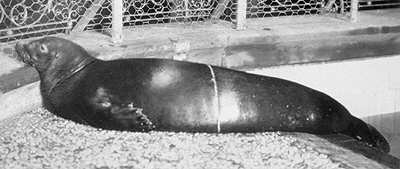 |
| Caribbean Monk Seal, New York Zoological Society, 1910 |
I first ran across the Caribbean monk seal in the New York Zoological Society records at the Wildlife Conservation Society in the Bronx. The New York Aquarium had a monk seal (referred to as a West Indian Monk Seal, in the early 20th century, and Charles Townsend, the director and one of the world's experts on pinnipeds, thought these animals were quickly disappearing in the wild. When Columbus first sailed into the tropical waters of the Caribbean, he encountered large amounts of seals. Mariners commonly killed seals for food and quickly numbers dwindled. The last reliable sighting of any Caribbean monk seals was of a small colony in a remote cay between Honduras and Jamaica in 1952. By 1977, they were officially declared extinct, with many mammalogists believing they had been extinct since that last sighting.
I'm not sure why I was thinking of these animals today, but I decided to poke about the internet, and found out that there are actually two existing, but struggling, relatives of the monk seal: the Mediterranean and Hawaiian monk seals. The Mediterranean monk seal is one of the most endangered mammals in the world, and the second most endangered pinniped behind the ringed seal. The Hawaiian monk seal isn't far behind. But, good news! There are big plans in the works to save the Hawaiian monk seal and they involve a Seal Hospital.
There are about 1,100 wild Hawaiian monk seals left (which is twice as many as Mediterranean monk seals) and they are struggling to maintain a flipper-hold in their environment. They are working their way onto crowded beaches, and human-seal interactions leave much to desire. To educate the public on proper seal interactions, NOAA produced an educational video (posted to my blog separately). But educating the public hasn't been enough, so the Marine Mammal Center in Sausalito has decided to build a Monk Seal Hospital to have a location to rehabilitate and care for injured seals before releasing them back into the environment.
This article in the San Francisco Chronicle includes a mock-up of the proposed seal hospital.
It includes two pools in which to rehabilitate the seals, both of which are open to the sea air and has line of sight to the ocean. Let's hope that the MMC's active plan to save the Hawaiian monk seal succeeds. The fact that they've come this far is incredibly heartening.
For information on the natural history of the seals, see:
Robert M. Timm, Rosa M. Salazar and A. Townsend Peterson. 1997. "Historical Distribution of the Extinct Tropical Seal, Monachus tropicalis (Carnivora: Phocidae)" Conservation Biology 11(2) 549-551.

No comments:
Post a Comment